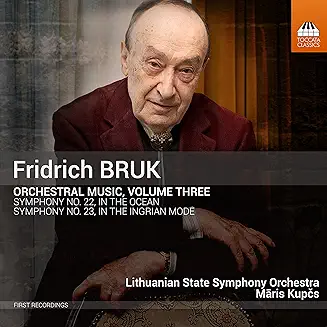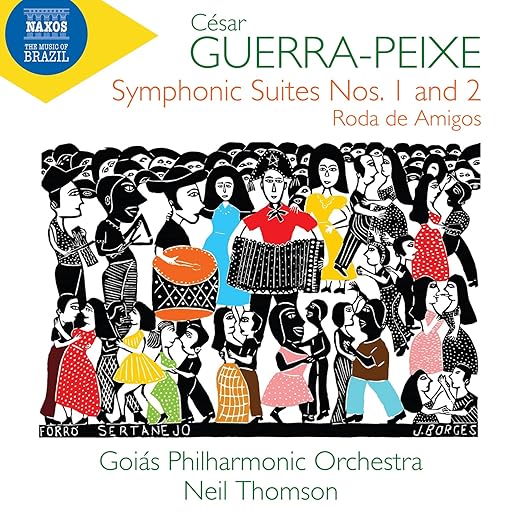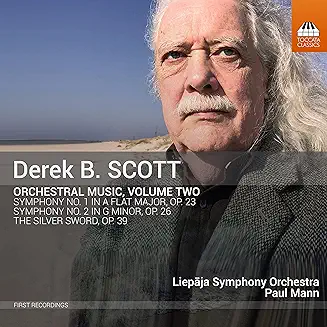Scott, D.B.: Orch Wks V2 (Sym No. 1 in A♭ major, Sym No. 2 in G minor, The Silver Sword); Mann/Liep SO [Toccata]
Last year the adventurous Toccata label gave us a CD with nine orchestral works by British composer-musicologist-educator Derek B. Scott (b.
1950; see Toccata-
0589). Now here's a welcome follow-up with three more, all being world premiere recordings. The composer's album notes give us detailed information regarding his background as well as the music here. Consequently, we'll just hit the high points.
Born in
Edgbaston, which is a suburb of
Birmingham, England, young Derek had an interest in music. This was encouraged by the lad's family and led to his studying composition at the
University of Hull (1972-1974). Subsequently, he's gone on to create a substantial body of
works with melodies that show him to be a great tunesmith, and often sound like they're from some popular song.
The two, four-movement symphonies here are succinct, consummate creations, which take their inspiration from Franz Joseph Haydn's (
1732-1809) many in that genre (
1757-1795). Both began life as band pieces (brass and percussion; 1995 & 1996-97), which the composer later rescored for full orchestra (2021), thereby giving us what's on this disc.
First off, there's the
Symphony No. 1 in A♭ major (Op. 23) that starts with a
sonata-form "
Allegro moderato (Moderately fast)" [T-1]. The exposition features an opening cocky bassoon motif (CB) [00:00], which is explored and followed by a songful melody [01:06]. These are then developed and recapitulated, thereby ending the movement triumphantly.
Next up, an "
Adagio (Slow)" [T-2] based on a
Scotch-Snap-spiced,
celtic-sounding tune [00:23]. Apparently, the composer could play the
Great Highland Bagpipe, and says it influenced what he wrote here. In any case, this is an engaging episode, which comes to a tranquil conclusion.
The following "
Allegro vivace ma non troppo (Lively and vivacious but not overly so)" Scherzo [T-3] is a captivating cavort that's as billed. It sets the stage for the "
Allegro (Fast)" Finale [T-4], which is another
sonata-form creation.
This has two ideas, the first being a CB-related, cocky number (CC) [00:01] that's succeeded by a
syncopated second [00:27]. These are food for developmental passages [00:47], which have a fugue based on a CC-like subject [02:20]. Then the foregoing ideas are recapitulated [04:08], and there's a CC-tinged,
campanological-enhanced coda [06:16] that ends the work in glorious, martial fashion.
Then we get its older brother, the
Symphony No. 2 in G minor (Op. 26). This has an initial "
Allegro (Fast)"
sonata-form movement [T-5], which opens with a fitful idea [00:01] that thrashes about, but coalesces into a haughty thought (HT) [01:07]. These undergo a spunky development [01:56] and recapitulation [04:09] with an outspoken coda [05:41], which ends things definitively.
The following "
Adagio (Slow)" is tinged with popular music of the composer's time as well as folksong melodies [T-6]. It begins with a binary thought having respectively wistful [00:01] and
arioso [00:27] components. These take on several guises that range from yearning [01:14] to confident [01:40], reassuring [02:03], martial [03:31], pastoral [04:18], outspoken [05:23] and regal [06:04]. Then a tranquil one [06:33] closes the movement peacefully.
A subsequent "
Allegretto (Lively)" Scherzo [T-7] has flirtatious passages [00:01, 00:48, 01:21, 02:14]. These alternate with boisterous ones [00:36, 00:59, 01:44, 03:01], the last of which brings this busy music to a rousing ending with four last
fortissimo chords [03:28].o
The Finale [T-8] begins with an "
Andante con moto (Slow with movement)" section that Scott refers to as "call-and-response" (CR). Here an oboe makes the "call" [00:01] and gets an immediate "response" from three trombones [00:06].
Then there's a marchlike episode [00:48] with hints of HT and CR. This evokes a forceful segment [03:17], which wanes into reminiscences of past ideas [03:39] and a big tune version of CR [04:22] that turns triumphant. It has remembrances of HT [05:10] and brings the work to a powerful conclusion with a CR-based, declaratory statement [06:38].
Last but not least, we get
The Silver Sword (Op. 39, 2021) [T-9], which is a tone poem. This takes its inspiration from English writer-poet Ian Serraillier's (
1912-1994) eponymous children's book (
1956), and you'll find an informative synopsis of it in the album notes.
The work begins with glowing, "
Adagio (Slow)" passages [00:01], which are soon interrupted by "
Tempo di marcia (March speed)" ones [02:05]. Then a flighty "
Allegro (Fast)" episode [02:47] is followed by a sorrowful, "
Andante (Slow)" section [04:18]. However, that "
Tempo di marcia (March speed)" returns [07:00], giving way to "
Adagio (Slow)" [07:58] memories of the opening measures. These suddenly become quite triumphant [09:03], but then wane, thereby ending the work and disc on a hopeful note.
Under British conductor Paul Mann (
b. 1965), the Liepāja Symphony Orchestra delivers terse, articulate readings of these selections. As on that previous Toccata release mentioned above, they again make a strong case for more Scott orchestral fare.
The recordings took place on 22-26 March 2022 at the
Great Amber Concert Hall in
Liepāja, Latvia, and project a consistently generous sonic image in affable surroundings. The overall instrumental timbre is characterized by steely highs, but acceptable mids and clean, low bass. Everything considered, the sound is good, but falls a bit short of an "Audiophile" rating.
--
Bob McQuiston, Classical Lost and Found (CLOFO.com, P221228)









